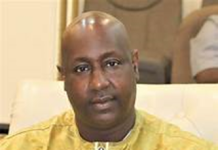By Amie Sanneh
A week long regional course on Exchange Rate Regimes and Policies is underway at a local hotel in Kololi.
Organised by the West African Institute for Financial and Economic management (WAIFEM), the course brought together participants from its member states namely: central banks of The Gambia, Ghana, Liberia, Nigeria and Sierra Leone
The meeting which opens yesterday, 13 June, 2016 is expected to end on Friday, 17 June, 2016.
Speaking on behalf of the Central Bank Governor, Basiru O. Njai, First Deputy Governor, said each country is free to adopt the exchange-rate regime that it considers optimal.
CBG’s First Deputy Governor added that most countries have adopted either fixed or flexible exchange rate regimes and there are several exchange rates in between such as crawling peg.
“Every exchange rate regime has its peculiarities, virtues and flaws. Determining the most appropriate exchange-rate regime for a country is, therefore, not a simple task. A country’s economy is hugely affected by this decision,” he said.
Njai explained that during times of inflationary pressure, a relatively high exchange rate reduces the price of imports and works to dampen inflationary pressure. However, he urged policy makers to keep an eye on export competitiveness, noting that if rates move too high, a country’s exports will become uncompetitive.
He said exchange rates can be manipulated by buying or selling currencies on the foreign exchange market and by increasing or decreasing interest rates which affect the demand and supply of the local currency.
“It is noteworthy that under all exchange rate regimes, other than absolutely free floating, ancillary policy to affect the foreign exchange market through official intervention must be given attention,” he said.
CBG’s First Deputy Governor noted that it is perilous and undesirable for a country to treat the exchange with benign neglect. “When the foreign exchange market is small and dominated by a relatively small number of agents, it is likely that the exchange rate will be volatile if the authorities do not provide some guidance and support,” he said.
This problem, he added, is even compounded in the absence of a long track record of stable macroeconomic policies that can firmly anchor market expectations.
Mr. Njai said in practice, therefore, countries that maintain relatively flexible exchange rate regimes use both monetary policy and official intervention to influence the exchange rate.
He further described intervention as more effective in countries where access to international capital market is limited so that the authorities have greater capacity to influence conditions in the foreign exchange market by directly buying or selling foreign exchange.
Speaking earlier, the Director General of WAIFEM, Prof. Akpan H. Ekpo said the course aims at introducing participants to the different regimes of exchange rate arrangements available to any economy. According to the WAIFEM head, participants are also expected to gain a deeper understanding of the different exchange rate regimes and to be exposed to the appropriate exchange rate policies for developing countries.
Prof. Ekpo said exchange rates affect cross-border economic transactions. Trade, investment, finance, tourism, migration and many more are all profoundly influenced by international monetary policies. He said as economies become “globalized”, more firms, investors and workers find their fortunes linked to the exchange rate and its impact on trade and financial flows.
Prof. Ekpo said many developing-country governments have searched for alternatives to the uncertainty that can prevail on international currency markets. “Policy makers have rushed to peddle currency nostrums, urging a turn toward dollarization, managed floating, nominal anchors, target bands, or other options,” he added.
Theoretically, noted the WAIFEM head, open-economy macroeconomic principles imply that capital mobility profoundly affects exchange rate policy choices, adding that as a result of the government of a financially integrated economy faces a choice between monetary policy autonomy and a fixed exchange rate. “If governments opt for a fixed rate, capital mobility makes impossible a monetary stance different from that of the anchor currency; alternatively, if governments opt to sustain an independent monetary policy, they must allow their currencies to float,” he emphasised.
According to him, these constraints mean that the economics and politics of monetary and exchange rate policy are likely to be different in an open economy than an economy that is not.
WAIFEM DG described all the currencies in the member-countries as nonconvertible and thus stressed the need for policy-makers to appreciate the skills necessary to manage exchange rates.
He acknowledges the Central Bank of The Gambia for the tremendous support they continue to enjoy in executing their mandate to build sustainable capacity in our sub-region.
WAIFEM DG used the opportunity to briefly talk about his institution which, he said, was established by the central banks of The Gambia, Ghana, Liberia, Nigeria and Sierra Leone in 1996, principally to build capacity for improved macroeconomic and financial and debt management in the constituent member countries.
He added that the mission of the Institute is to develop, on a sustainable basis, expertise in the fields of Macroeconomic, Debt and Financial Sector Management among the staff of central banks, ministries of finance and economic planning and other public sector bodies with core economic management responsibilities. So far, he said, the Institute has successfully executed over 554 Courses since inception, and these have benefited more than 15,173 participants from the sub-region and beyond.
According to officials, the course has been designed to cover key topics such as:
Review of exchange rate regimes; measures of real exchange rates; money, interest rates and exchange rates; exchange rate management and policy implications; exchange rate regimes and monetary policy; trends in exchange rates of ECOWAS currencies, amongst others.



















